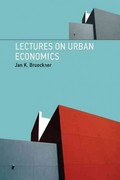Question
2) Consider a location model of differentiated products where the set of possible products is the line segment [0,1] and consumers are uniformly distributed along
2)Consider a location model of differentiated products where the set of possible products is the line segment [0,1] and consumers are uniformly distributed along the line segment.Transportation costs in this model are equal to td, where d= |x - x*|is the distance between the consumer's ideal variety and the variety she purchases. If a consumer with ideal variety x* purchases variety x at price p, then her utility is
u = s - p - t( |x - x*| ).
If the consumer does not purchase the good her utility is u = 0. A consumer buys the good only if her utility from buying is at least zero.
a)Suppose the market is served by a monopolist selling variety x = . For given s and t, find the demand the monopoly faces as a function of p (remember, consumers want to buy the good only if their utility is non-negative). Make sure that as part of your answer you specify (i) for which range of prices no consumer would want to buy the good so that demand is zero [hint: even the consumer located at x=0.5 does not buy]; (ii) for which range of prices all consumers would
want to buy the good [hint: even the consumer located at x=0 wants to buy the good]; (iii) For the range of prices such that some consumers buy, and some do not, state how demand depends on the price. [Hint: what is the location of a consumer who is indifferent between buying and not buying? Consumers who are closer, will but].
b)Explain in words why a monopolist selling variety x = is better off the smaller is t.
c)Assume now that the market is served by 2 firms located at 0 and 1. Each firm has a marginal cost of production c. Assume all the consumers buy, find the equilibrium. [Hint: This is what we did in class.]
d)Explain in words why a (when all the market is served) a duopolist selling variety x = 0 and facing a rival who sells variety x = 1 may be better off the bigger t.
3)Consider a location model of differentiated products where the set of possible products is the line segment [0,1] and consumers are uniformly distributed along the line segment.Assume that the transportation costs is quadratic td2, where d= |x - x*|is the distance between the consumer's ideal variety and the variety she purchases. If a consumer with ideal variety x* purchases variety x at price p, then her utility is
u = s - p - t( x - x*)2.
If the consumer does not purchase the good her utility is u = 0. A consumer buys the good only if her utility from buying is at least zero. Suppose the market is served by 2 firms located at 0 and 1. Each firm has a marginal cost of production c. Assume all the consumers buy, find the equilibrium.
Step by Step Solution
There are 3 Steps involved in it
Step: 1

Get Instant Access to Expert-Tailored Solutions
See step-by-step solutions with expert insights and AI powered tools for academic success
Step: 2

Step: 3

Ace Your Homework with AI
Get the answers you need in no time with our AI-driven, step-by-step assistance
Get Started


